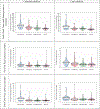Parkinson's Disease Cognitive Phenotypes Show Unique Clock Drawing Features when Measured with Digital Technology
- PMID: 33682726
- PMCID: PMC8108094
- DOI: 10.3233/JPD-202399
Parkinson's Disease Cognitive Phenotypes Show Unique Clock Drawing Features when Measured with Digital Technology
Abstract
Background: A companion paper (Crowley et al., 2020) reports on the neuroimaging and neuropsychological profiles of statistically determined idiopathic non-dementia Parkinson's disease (PD).
Objective: The current investigation sought to further examine subtle behavioral clock drawing differences within the same PD cohort by comparing 1) PD to non-PD peers on digitally acquired clock drawing latency and graphomotor metrics, and 2) PD memory, executive, and cognitively well phenotypes on the same variables.
Methods: 230 matched participants (115 PD, 115 non-PD) completed neuropsychological tests and dCDT. Statistically-derived PD cognitive phenotypes characterized PD participants as PD low executive (PDExe; n = 25), PD low memory (PDMem; n = 34), PD cognitively well (PDWell; n = 56). Using a Bayesian framework and based on apriori hypotheses, we compared groups on: total completion time (TCT), pre-first hand latency (PFHL), post-clock face latency (PCFL), total clock face area (TCFA), and total number of pen strokes.
Results: Fewer strokes and slower performance to command were associated with higher odds of PD diagnosis, while a larger clock face in the copy condition was associated with lower odds of PD diagnosis. Within PD cognitive phenotypes, slower performance (TCT, PCFL) and smaller clock face to command were associated with higher odds of being PDExe than PDWell, whereas larger clock faces associated with higher odds of being PDMem than PDWell. Longer disease duration, more pen strokes (command) and smaller clocks (command) associated with higher odds of being PDExe than PDWell.
Conclusion: Digitally-acquired clock drawing profiles differ between PD and non-PD peers, and distinguish PD cognitive phenotypes.
Keywords: Parkinson’s disease; bayesian analysis; executive function; memory; propensity score analysis.
Figures



References
-
- Dubois B, Burn D, Goetz C, Aarsland D, Brown RG, Broe GA, Dickson D, Duyckaerts C, Cummings J, Gauthier S, Korczyn A, Lees A, Levy R, Litvan I, Mizuno Y, McKeith IG, Olanow CW, Poewe W, Sampaio C, Tolosa E, Emre M (2007) Diagnostic procedures for Parkinson’s disease dementia: recommendations from the movement disorder society task force. Movement Disorders 22, 2314–2324. - PubMed
-
- Cosentino S, Jefferson A, Chute DL, Kaplan E, Libon DJ (2004) Clock Drawing Errors in Dementia, Neuropsychological and Neuroanatomical Considerations. Cognitive Behavioral Neurology 17, 74–84. - PubMed
-
- Ogden JA, Growdon JH, Corkin S (1990) Deficits on visuospatial tests involving forward planning in high-functioning Parkinsonians. Neuropsychiatry, Neuropsychology, & Behavioral Neurology 3, 125–139.
-
- Grossman M, Carvell S, Peltzer L, Stern MB, Gollomp S, Hurting HI (1993) Visual Construction Impairments in Parkinson’s Disease. Neuropsychology 7, 536–547.
Publication types
MeSH terms
Grants and funding
LinkOut - more resources
Full Text Sources
Other Literature Sources
Medical

